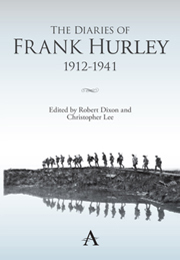Book contents
- Frontmatter
- Contents
- List of Illustrations
- Introduction
- Acknowledgements and Notes on the Text
- 1 Sledging Diary, the Australasian Antarctic Expedition (November 1912–January 1913)
- 2 The Imperial Trans-Antarctic Expedition Diary (November 1914–April 1917)
- 3 The Great War Diary (August 1917–August 1918)
- 4 Tour Diary – In the Grip of the Polar Pack-Ice (December 1919–January 1920)
- 5 The Torres Strait and Papua Expedition Diaries (December 1920–August 1921)
- 6 The Papua Expedition Diary (August 1922–January 1923)
- 7 The World War II and Middle East Diaries (September 1940–October 1941)
- Index
Introduction
Published online by Cambridge University Press: 05 March 2012
- Frontmatter
- Contents
- List of Illustrations
- Introduction
- Acknowledgements and Notes on the Text
- 1 Sledging Diary, the Australasian Antarctic Expedition (November 1912–January 1913)
- 2 The Imperial Trans-Antarctic Expedition Diary (November 1914–April 1917)
- 3 The Great War Diary (August 1917–August 1918)
- 4 Tour Diary – In the Grip of the Polar Pack-Ice (December 1919–January 1920)
- 5 The Torres Strait and Papua Expedition Diaries (December 1920–August 1921)
- 6 The Papua Expedition Diary (August 1922–January 1923)
- 7 The World War II and Middle East Diaries (September 1940–October 1941)
- Index
Summary
Frank Hurley is best known today as a photographer and filmmaker, and it has become common to refer to his major works by the titles of his documentary films: The Home of the Blizzard, In the Grip of the Polar Pack-Ice, Sir Ross Smith's Flight and Pearls and Savages. But Hurley did not work in a single medium: he was an old-fashioned showman whose repertoire included both traditional and modern media, which he used in both old and new ways. The shows he put on at the height of his fame in the 1910s and 1920s were not documentary films in the modern sense, but complex multimedia performances that he called ‘synchronized lecture entertainments’. They used a combination of photographic exhibition, saturation newspaper coverage, the presence of a celebrity lecturer or ‘platform personality’, silent cinema projection, coloured glass lantern slides, live musical accompaniment, themed theatre decorations, and mainstream book publication, all ‘tied in’ to achieve maximum advertising exposure. The performances were entertaining as well as educational, drawing as much attention to their own attractions as to the events they purported to represent. There was about them a sense of self-promotion and opportunistic contrivance that sometimes attracted criticism: they smacked of what contemporary pressmen called stunts. Hurley's shows toured Australia's capital cities and regional towns and they often took place simultaneously overseas by arrangement with various entertainment agencies in New Zealand, Great Britain, Europe, the United States and Canada.
- Type
- Chapter
- Information
- The Diaries of Frank Hurley 1912–1941 , pp. xi - xxxviiiPublisher: Anthem PressPrint publication year: 2011



